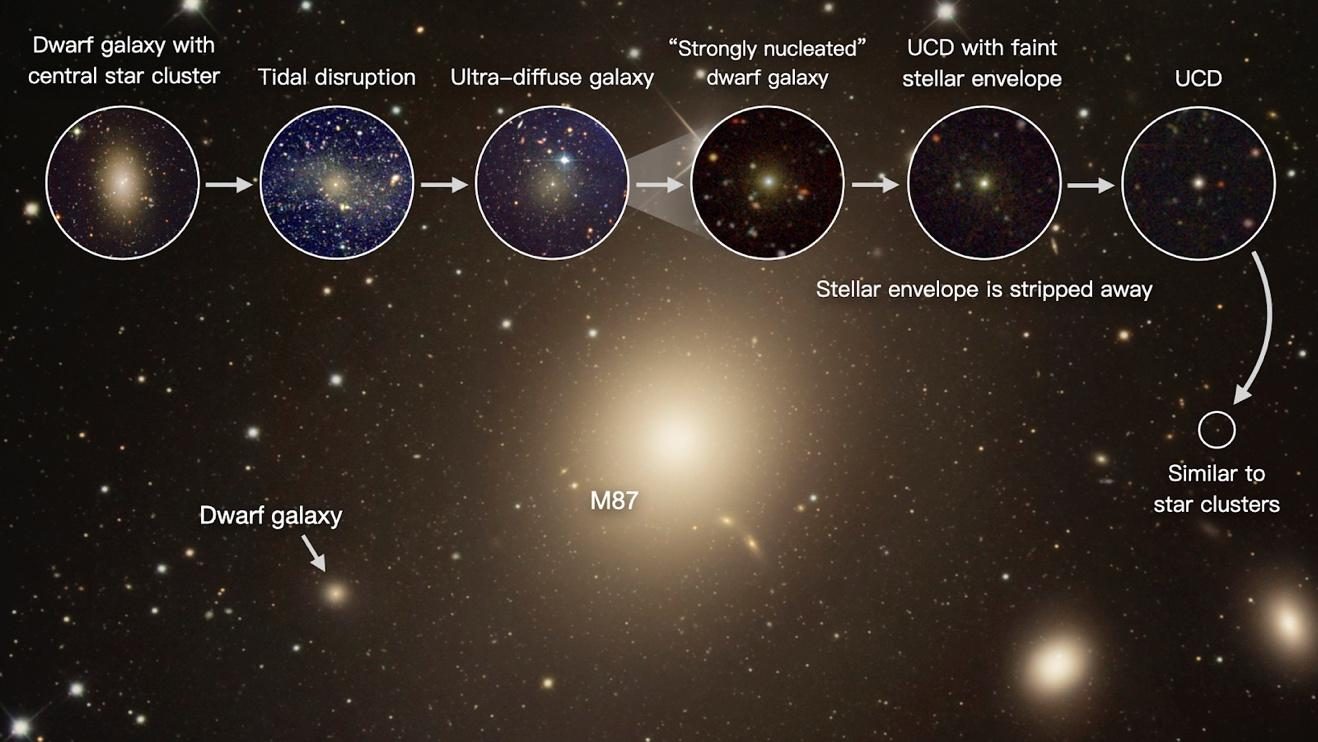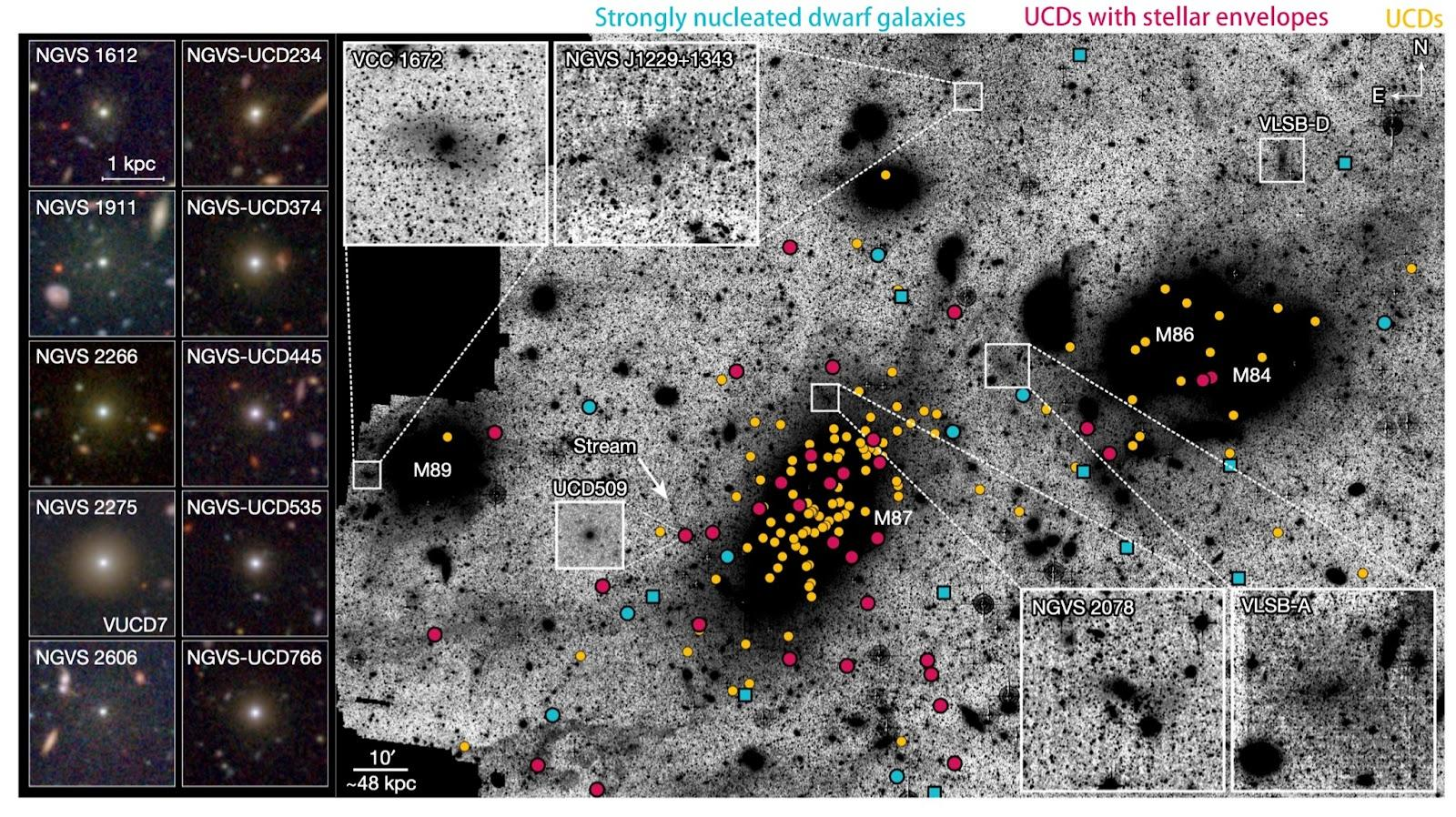PKU astronomers reveal the formation of dense dwarf galaxy ‘fossils’
Nov 09, 2023
Peking University, November 9, 2023: An international team of astronomers using the Canada-France-Hawaii Telescope (CFHT), Gemini North telescope (Gemini North), Hubble Space Telescope (HST), and Case Western Reserve University's Burrell Schmidt Telescope has captured the eroding remains of more than 100 galaxies in an elusive state of transformation. Their findings confirm that some of the densest galaxies in the Universe — dubbed “ultra-compact dwarfs” (UCDs) — are likely the fossil remains of normal dwarf galaxies that have been stripped of their outer layers. The results were reported in a recent article titled “An evolutionary continuum from nucleated dwarf galaxies to star clusters,” and were published on Nov. 9, 2023, in Nature. This research was led by Wang Kaxiang, a Ph.D. student at Peking University (PKU), and Eric Peng, a former professor at PKU.
Ultra-compact dwarf galaxies (UCDs) are among the densest stellar groupings in the Universe. Being more compact than other galaxies with similar mass, but larger than star clusters — the objects they most closely resemble — these mystifying objects have defied classification. In the past two decades since the discovery of ultra-compact dwarf galaxies, there has been controversy over their nature: are they truly compact galaxies, or are they the most massive globular clusters (GCs)? The idea that UCDs are remnants of disrupted nucleated dwarf galaxies was proposed shortly after they were discovered. Evidence including the discovery of central supermassive black holes, extended star formation history, and faint stellar envelopes around some UCDs, support the tidal stripping scenario. However, previous searches have not revealed the large population of galaxies-in-transition that one would expect to find during such a process.
To find the missing link between nucleated dwarf galaxies and ultra-compact dwarf galaxies, an international team of astronomers conducted a systematic search for these intermediate-stage objects in the Virgo Cluster, a grouping of thousands of galaxies in the direction of the constellation Virgo. The team compiled their sample by first looking at images from the Next Generation Virgo Cluster Survey (NGVS), taken with the Canada-France-Hawaiʻi Telescope, as well as archival HST images. About 15% of Virgo UCDs have been found to have diffuse stellar envelopes around them.
To distinguish the bona-fide UCDs from the background galaxies, the team performed follow-up spectroscopic studies with Gemini North to obtain more concrete measurements of their distances. These observations allowed the astronomers to eliminate all of the background galaxies from their samples until only the UCDs within the Virgo Cluster remained.
Besides UCDs with diffuse envelopes, the team also identified a small fraction of dwarf galaxies that contain very prominent central star clusters, named “strongly-nucleated” dwarf galaxies in this study. These galaxies were found to share similar morphology, spatial distribution, and colors with UCDs with stellar envelopes. They likely represent the early stages of the transformation process and suggest that after neighboring massive galaxies strip these dwarfs of their outer layers of stars and gas, what remains will be an object identical to the late-stage UCDs that have already been identified.
“Our results provide the most complete picture of the origin of this mysterious class of galaxy that was discovered nearly 25 years ago,” said Eric Peng, who now works at the NOIRLab. “Here we show that 106 small galaxies in the Virgo cluster have sizes between normal dwarf galaxies and UCDs, revealing a continuum that fills the ‘size gap’ between star clusters and galaxies,” Peng added.
Fig.1. The Left two columns show the color images of some strongly-nucleated dwarf galaxies and UCDs with stellar envelopes found in this study. The right panel shows their distribution in the Virgo core region. They are mostly concentrated in the central giant elliptical galaxy, M87. Credit: Wang et al. 2023
The researchers also found very extended and diffuse stellar envelopes and tidal streams around some strongly-nucleated dwarf galaxies and UCDs with envelopes, indicating that they are indeed currently in the throes of transitioning as their stars and dark matter is stripped away. Within their extensive sample, the team identified objects at several stages of the evolutionary process that, when placed in sequence, tell a compelling story of the morphology of UCDs. Furthermore, nearly all the candidates were near massive galaxies, suggesting that their local environment plays an important role in their formation.
“Once we analyzed the Gemini observations and eliminated all the background contamination, we could see that these transition galaxies existed almost exclusively near the largest galaxies. We immediately knew that environmental transformation had to be important,” said Wang Kaixiang.
Besides identifying the environment UCDs live in, these results also lend valuable insight into how extreme galaxies in the Universe may form. The most diffuse galaxies in the universe (ultra-diffuse galaxies - UDG) and the most compact galaxies (ultra-compact dwarf galaxies - UCD) may have a common origin, both evolving from normal galaxies. Ultra-diffuse galaxies could be an intermediate stage in the evolution of dwarf galaxies into ultra-compact dwarf galaxies. When a significant amount of dark matter in a galaxy is first stripped away by tidal forces, the distribution of stars within the galaxy becomes much more diffuse than before. As the peripheral stars of the galaxy are gradually stripped away, the central nucleus of stars remains, forming an ultra-compact dwarf galaxy.

Fig. 2. A continuum of galaxies captured at different stages of the transformation process from a dwarf galaxy to an ultra-compact dwarf galaxy (UCD). These objects are located near the giant elliptical galaxy M87, the dominant member of the neighboring Virgo Cluster. Credit: NOIRLab/NSF/AURA/NASA/K. Wang/R. Gendler
"It's exciting that we can finally see this transformation in action," said Peng, "It tells us that many of these UCDs are visible fossil remnants of ancient dwarf galaxies in galaxy clusters, and our results suggest that there are likely many more low-mass remnants to be found." "Meanwhile, these UCDs serve as an important probe for reconstructing the accretion history of the Virgo Cluster and central massive galaxies like M87," he added.
The paper, with further details, is available at the provided URL: https://www.nature.com/articles/s41586-023-06650-z
Source: The Kavli Institute for Astronomy and Astrophysics, Peking University

